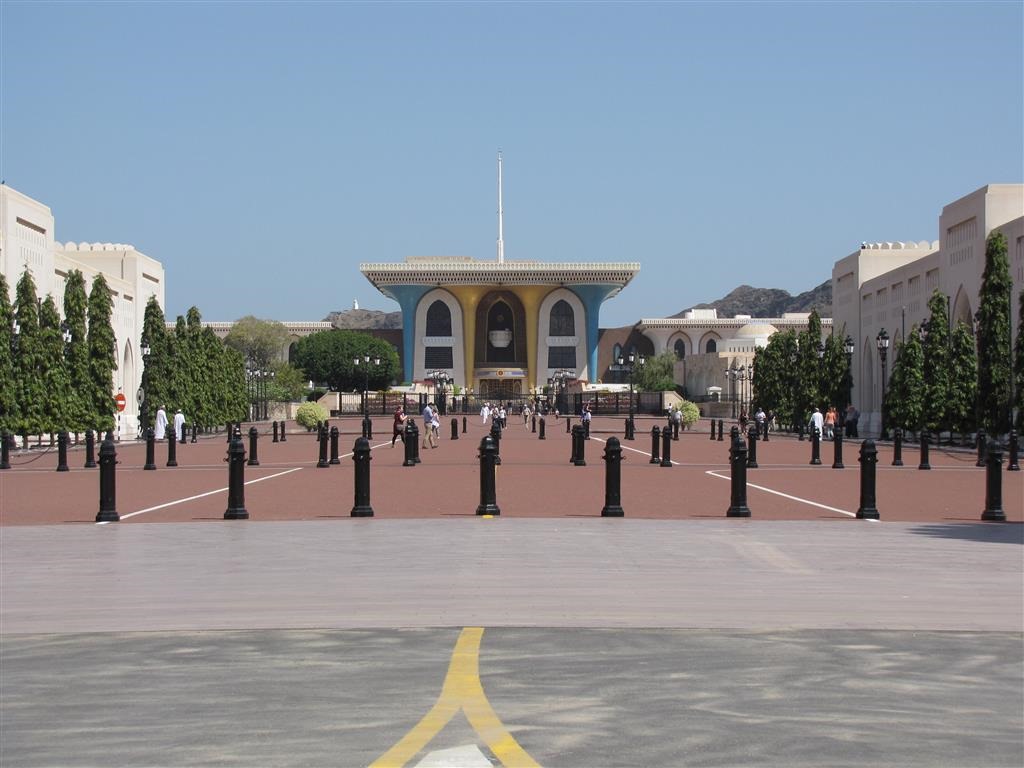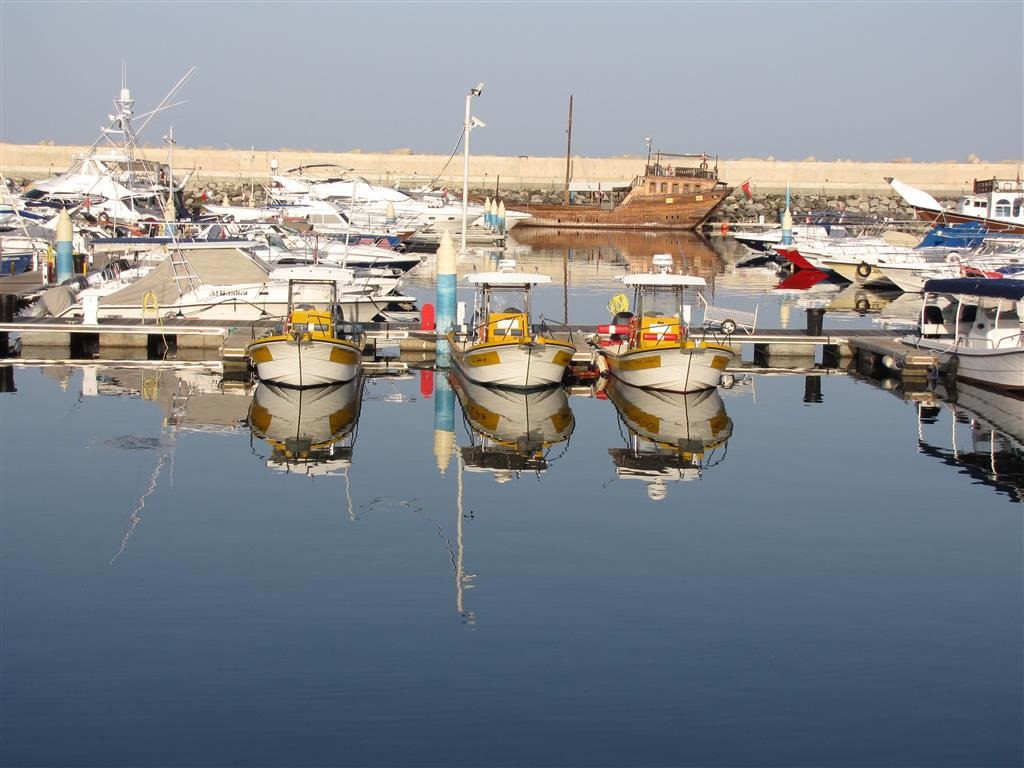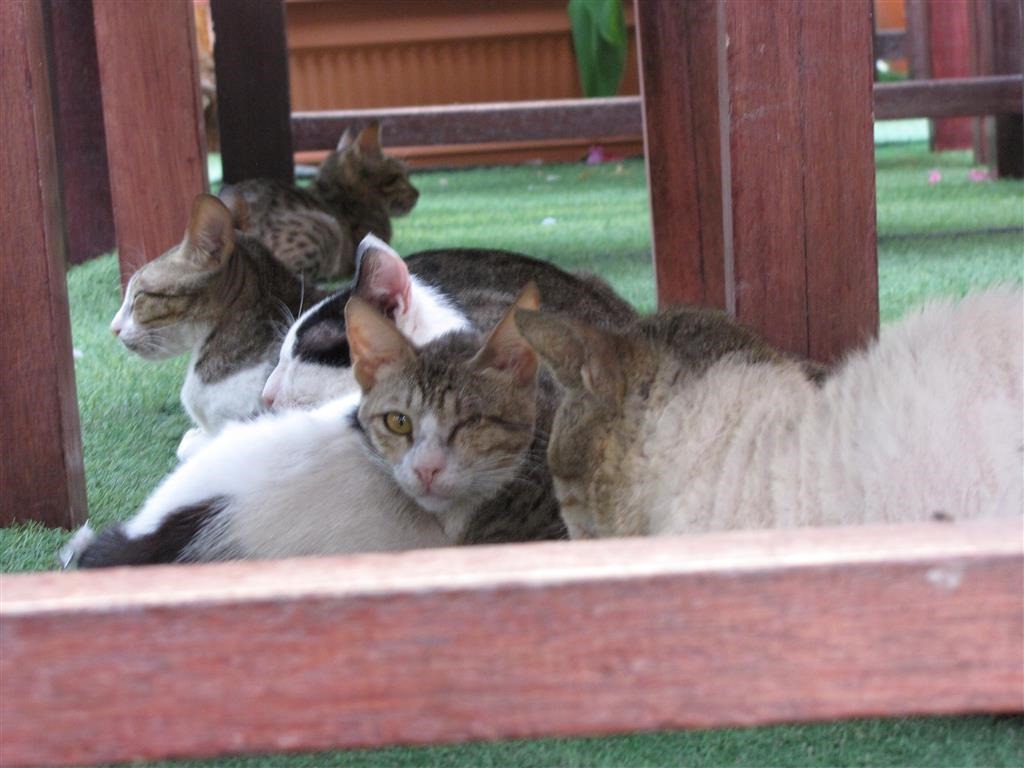(Blog post by Joel)
Qatar is pretty much as flat as a board. Except for the bits where there are sand dunes, there’s barely the slightest hill or slope anywhere – its highest point is just 100 metres above sea level. Oman is pretty much the exact opposite – there are mountains literally everywhere. In fact, there’s a huge one visible outside our hotel window. Here’s the view outside the hotel window.
 Also, the hotel lobby and exterior (our room’s on the first floor, the window directly behind the hotel sign, plus the one to the left).
Also, the hotel lobby and exterior (our room’s on the first floor, the window directly behind the hotel sign, plus the one to the left).

Oman is a country on the pointy end of the Arabian Peninsula. Like the other Arabian nations, it’s an Islamic country. Ruled by Sultan Qaboos Bin Said Al Said, it’s actually one of only two countries remaining in the world that are Sultanates, the other one being Brunei (though the Yogyakarta Special Region in Indonesia and seven of the nine Malay states in Malaysia are also ruled by sultans). Originally settled by Arab tribes migrating from Yemen yonks and yonks ago, the Persians brought Islam here and ruled until the Portuguese invaded in 1507 – the Portuguese built a number of forts to defend the city, many of which still exist today. Ottoman Turks captured it from the Portuguese in 1552, and the two basically took it from each other for the next couple of centuries until an Omani tribe managed to throw everyone out in 1741. At that point, Oman became a power in its own right, vying with both the British and the Portuguese for control of the region. In 2010, Oman was judged the most improved nation in the world in terms of development – it’s got fairly modest (but valuable) oil reserves but derives a significant portion of its income from tourism and trade of fish, dates and produce.
Whew. Muscat is the capital and most populous city in Oman – in fact, prior to the current Sultan attaining the throne, the country was named “Muscat and Oman”. Squished between the mountains and the sea, Muscat is kind of very long and very thin, being about forty kilometres long, but only about five kilometres wide (up to ten at the widest bit). Actually, our hotel’s almost at the farthest end of Muscat from the airport.
Today following breakfast at the cafe in the hotel lobby, we headed for central Muscat, as near as Muscat has a “central”. Impressive highway on the way – street lights all the way along, same as Qatar. Some pretty spectacular buildings on the way, too.




We started with a brief drive along Muscat’s Corniche. Lots and lots of tourists around. In Qatar, I don’t think I’ve seen a single tourist – or rather, no obvious tourists, but maybe some of the people I took to be expats were actually tourists – but here they were being shuttled around by the busload. Probably helps that we could see three cruise ships in port; two from German company Aida, and one from Costa, the Costa Fortuna (or, as R put it, “How much is that cruise ship over there?” “It’sa Costa Fortuna”). We also saw the Sultan’s private yacht. I wants one, precious.


 But anyway, after our little drive, we headed for the Bait al Zubair museum. The name basically means “House of Zubair” – it was formerly a house belonging to the Zubair family, which was converted into a museum in 1998. The main galley building – Bait al Bagh – had a display of various old Omani objects – clothing, houseware, instruments, weaponry, and even coins and stamps upstairs. Apparently, it’s well known for its extensive collection of khanjar (tradition al Omani daggers). Out the back, there was a traditional palm-frond house we could go into, and a huge model of a mountain village, complete with river running through it. Most impressive. Most buildings didn’t allow pictures inside, incidentally. Think R took some anyway.
But anyway, after our little drive, we headed for the Bait al Zubair museum. The name basically means “House of Zubair” – it was formerly a house belonging to the Zubair family, which was converted into a museum in 1998. The main galley building – Bait al Bagh – had a display of various old Omani objects – clothing, houseware, instruments, weaponry, and even coins and stamps upstairs. Apparently, it’s well known for its extensive collection of khanjar (tradition al Omani daggers). Out the back, there was a traditional palm-frond house we could go into, and a huge model of a mountain village, complete with river running through it. Most impressive. Most buildings didn’t allow pictures inside, incidentally. Think R took some anyway.






We then headed for lunch at the museum’s cafe, which was located in Bait al Daleel, a restored old-style Omani house. Aside from the cafe itself, the rest of the house was made up to look like how it used to be, including entertaining rooms, a storage cellar for dates, and a wind tower, which helps circulate air through the house. The cafe itself was full of all manner of books to read – as well as books on Islamic culture and art, there were also books on several other random subjects, like Japanese ukiyo-e art and an encyclopedia of brand logos, for some odd reason. Anyway, we all had sliders for lunch. Fairly tasty. Not really going to be toppling the best-in-Qatar throne, though.




After lunch, we wandered through another gallery (Bait al Oud). The ground floor had a display of paintings by an artist whose name I’ve forgotten. The first floor had a display of old furniture, and an exhibit of old maps of the area. Curiously, most of them showed no sign of the Qatar peninsula, only displaying an oversized version of Bahrain instead. The Qatar peninsula suddenly pops into existence around 1880. Magic. In any case, the top floor had displays of painting and photographs of ye olde Oman.


Once we were done there, we headed back down the coast to Marina Bander al Rowdha, where we hopped onto a boat for a shoreline cruise. Basically, he took us south along the coast for about an hour, where we saw several fishing villages, and hotels, more than a few cormorants airing their wings, and great amounts of craggy rocks.










Then he drove north at top speed until we reached the cruise terminal again, and headed south back to the marina – here we saw several forts, and a few Portuguese graveyards. We also saw one fishing village with a prominent mosque, and I was somewhat intrigued by the juxtaposition of the line of boats along the seashore in front of the mosque. I guess it shouldn’t be terribly surprising, but it’s something that struck me.












Lovely cruise, though. Comfy seats, free drinks, and absolutely ideal weather for it. Took about two hours in all.
Headed back to the Corniche to visit Muttrah Souq. This was just as crowded and bustling as Souq Waqif, though unlike Souq Waqif, which was built especially, Muttrah Souq appears to have been simply converted from existing alleyways between buildings (only with roofs built over the top – just corrugated iron and plywood in some places, but more properly in others). It was heaps of fun, thought I was almost afraid to actually look at anything, because whenever I did so, someone would leap out of the stall and try to sell it to me.









After wandering around there for a while, we headed for dinner at a place called Cafe Chef-A – mum and dad had eaten there before. It was very tasty, though it was pretty much thronging with stray cats. When the waiter brought the food over, they all came around to meow at us. At one point, I leaned forward to reach the food, and felt something warm land on my back. Thinking the cushion had just fallen over, I sat back, only to discover a cat on the bench behind me. Fending it off without touching it with my hands was a challenge, i must say. At one point, I was forced to get rid of one particularly eager cat by flicking water at it from my water bottle, but after that I discovered I could get the same effect by just shaking my water bottle at them. Good food, though. I had a blueberry milkshake with it.





We stopped on the way home for some nighttime photography of Al Alam Palace, the Sultan’s palace, and some of the nearby forts.





And whew, today turned out to be a busy day. Not too sure what we’ve got left to do tomorrow. Maybe go back to the souq at some point and actually buy some souvenirs.
Today’s photo count: Seven hundred and twelve. A fair few more than previous days.
